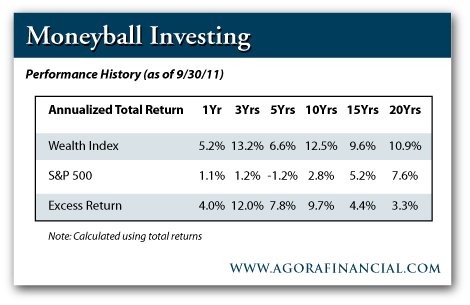
The key dilemma around Moneyball, the book by Michael Lewis and the movie based on it (I recommend both), is pretty simple.
The New York Yankees had a payroll of $126 million in 2002. The Oakland A’s had a payroll of only $40 million. How does an underfunded, outgunned outfit like the A’s compete with the Yankees? As A’s General Manager Billy Beane puts it in the movie: “There are rich teams, and there are poor teams. Then there’s 50 feet of crap. And then there’s us.”
Beane realizes he can’t look at the player acquisition game the same way the Yankees do and win. He has to figure out a different way to find winning players. Fortunately, he meets Peter Brand (in real life, Paul DePodesta, who didn’t want his name used in the movie version), who introduces him to a set of ideas the rest of baseball ignores.
While other teams focus on apparent athletic talent, Brand focuses on how teams actually win. Teams win by creating, or preventing, runs. Using statistical methods, Brand focuses on players that create runs — instead of how fast they run, how far they can throw, or how far they hit the ball.
Of course, the A’s become winners on a low budget with overlooked players. They set an American League record winning 20 games in a row on their way to an impressive 103-win season.
You can probably already sense how this is relevant to investing. Whether you realize it or not, you are in a position a lot like the A’s — maybe 100 times worse. The financial markets are probably the most-competitive field of endeavor on the planet. There is a lot of brainpower and financial muscle trying to “win.” You need to look at the market differently to beat it.
Beane looked for ballplayers who created runs based on the theory that runs win ballgames, instead of focusing on obvious athletic ability, which is what everyone else was doing.
Over the long haul of a 162-game season, the odds would pile up in his favor. Likewise, in the market, we want stocks that create shareholder wealth, on the theory that stock prices will follow. This is an important, if basic, insight. We don’t want to look for high dividend yields or low price-to-earnings ratios or good-looking stock charts or any of the superficial things everyone else focuses on.
“Everyone else” is a lot like the old baseball scouts that focus on how fast a guy can run or how well he throws — or even if he has a pretty girlfriend. (From the movie: “He’s got an ugly girlfriend.” “What does that mean?” “Ugly girlfriend means no confidence.”) These attributes have little to do with whether a guy can create runs. In the same way, the glamour statistics and charts alone don’t really get at wealth creation.
Wealth creation is ultimately measured in the ability to create cash. Cash, though, comes from all kinds of sources — rising asset values, sales of assets, earnings, dividends, etc. — ultimately reflected in stock prices.
In markets, one of the best predictors of wealth creation is ownership by the people in charge. Hardly anyone focuses on ownership. Ask a CNBC talking head how much stock the CEO owns of his favorite play? He won’t know. Heck, ask most fund managers how much skin their management team has in the game. They won’t know either. They don’t look for it. And that is your opportunity.
One interesting way to look at this idea was put forward by Horizon Kinetics, one of the few firms I know of that focuses on ownership. In fact, the firm created the Horizon Kinetics ISE Wealth Index, a benchmark tracking the most-successful business leaders. According to the firm’s website, the index includes:
…companies whose senior management has demonstrated a track record of skill and specific industry knowledge that has translated into high levels of long-term shareholder value creation. In many cases, these individuals have also used their respective companies as the primary means for accumulating substantial personal wealth…
Due to this vested interest factor, these management teams often prioritize the creation of long-term shareholder value and, as a result, outperform the markets.
And the proof in the pudding is in the table below…

To get in the Wealth Index, a company must meet several criteria. One is simply that there must be a wealthy individual in a position of control (e.g., chairman, CEO). Wealthy means at least $1 billion in personal assets, as measured by public data. So the members of this index are, essentially, a list of companies with a billionaire owner-manager.
You can find the 98 stocks in the index at http://www.ise.com/index. Click on “Index Options,” which is under “Products Traded.” Then scroll down the table to find the index (the ticker is RCH), and then click “View.”
Not surprisingly, the index includes six current holdings in my Capital & Crisisnewsletter, including Federal-Mogul (FDML), which counts legendary investor Carl Icahn as its majority shareholder. I think it’s going to be one of the market’s top-performing stocks over the next few years.
Having owner-operators with a track record is critically important if you are a long-term investor. As Warren Buffett pointed out, “After 10 years on the job, a CEO whose company annually retains earnings equal to 10% of net worth will have been responsible for the deployment of more than 60% of all the capital at work in the business.” Talk about having an impact!
Buffett, too, is a big believer in what he calls “the biblical standard” (quoting Matthew 6:21: “For where your treasure is, there will your heart be also”). He wrote in his 2004 annual letter that every director of Berkshire Hathaway was a member of a family owning at least $4 million in stock. None of them acquired shares with options or grants. “Charlie [Munger] and I love such honest-to-God ownership,” Buffett writes. “After all, who ever washes a rental car?”
It’s a simple thing, yet nearly all the financial world’s eyes focus on everything but this. By focusing on this pool of Wealth Index companies, you vastly increase your odds of success — as the table above shows.
In Moneyball, Beane succeeds because he focuses on those basic odds. “We are card counters at the blackjack table,” Beane says. “And we’re gonna turn the odds on the casino.”
You can do the same in the stock market by limiting yourself only to companies that exhibit one of the chief characteristics of wealth creation: significant ownership by the people in charge.
Regards,
Chris Mayer,
for The Daily Reckoning
Editor’s Note: Chris’ insights are among the most valuable and time- tested we can think of. Subscribers to his Capital & Crisis newsletter know that better than anyone — it has one of the highest renewal rates of any Agora Financial publication. That means when people sign up for Chris’ advice they aren’t just taking it…they’rekeeping it; knowing they can rely on it when they need it most. Click here now to find out why they find this service so invaluable.












